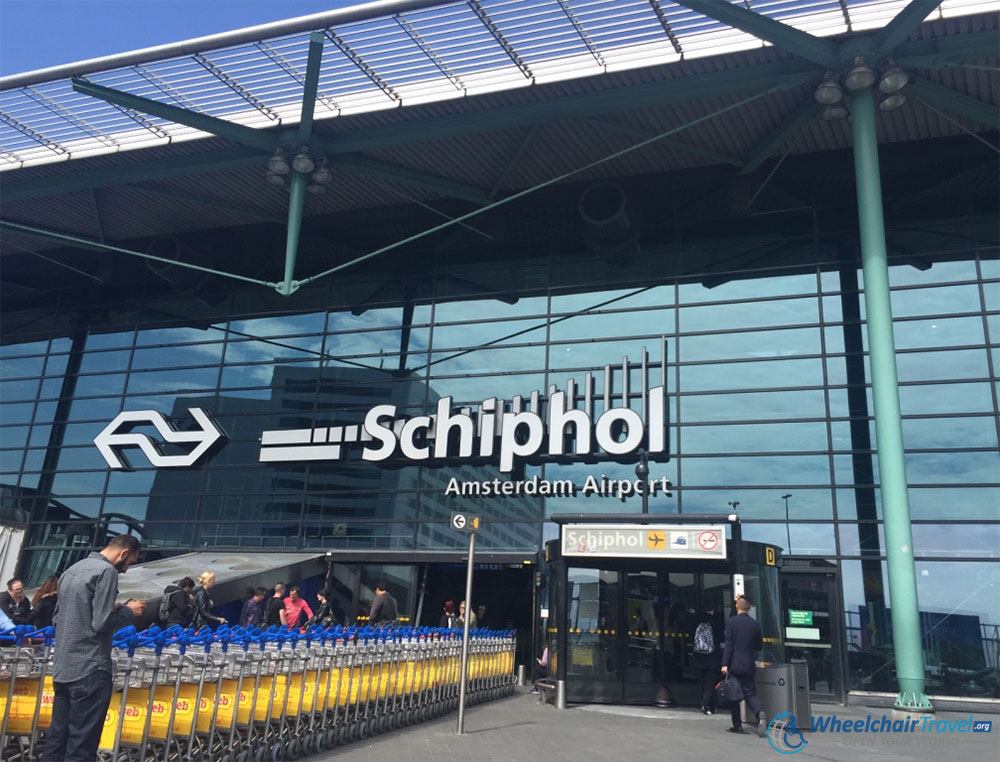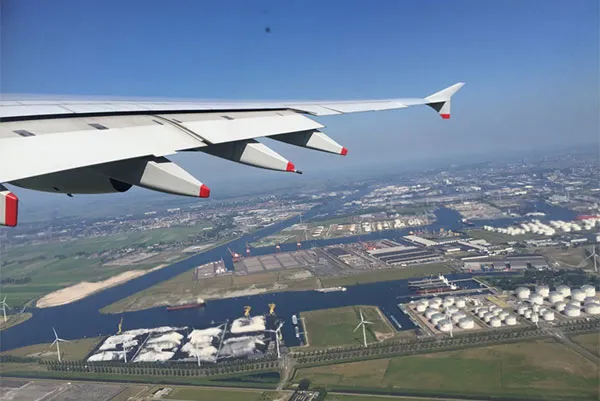
The city of Amsterdam is served by Amsterdam Airport Schiphol (AMS). Schiphol is a major SkyTeam hub and is the home base of Dutch flag carrier KLM Royal Dutch Airlines. It is. the fifth busiest airport in Europe.
I have flown through, departed from or arrived to Amsterdam’s airport more than 25 times with my power wheelchair. My associated flights have been operated by numerous carriers, including Air France, British Airways, China Southern, Delta, and KLM, on both intercontinental and intra-European (Schengen and non-Schengen) flights. The information contained here is from my own experiences, which are quite diverse.
The airport is a single terminal, with three departure halls, numbered 1, 2 and 3. Within these departure halls are piers, individually lettered B, C, D, E, F, G, H and M. All departure halls and piers are connected to one another in the airside secure area, with the exception of pier M, which serves low-cost carriers such as easyJet and Norwegian Air Shuttle. Passport Control separates the terminal. The Schengen zone contains gates serving flights to destinations within the European Schengen Area. The non-Schengen zone is the international area, with flights bound for European cities not in the Schengen area or flights to other continents.
As of June 2015, a new central security policy has been implemented at the Amsterdam Airport. What you can expect depends on where you are coming from, and whether you are arriving to Amsterdam, or connecting to another flight. I have personally flown to or through AMS in each of these scenarios. If you’re not interested in the nuances of passport control, customs and security, jump to information on wheelchair access at AMS.
My destination is Amsterdam, and I have flown from a non-Schengen country.
I most recently flew directly to Amsterdam from London, United Kingdom. Because the U.K. is outside of Europe’s Schengen Area of passport-free movement, the procedure is the same as if I were arriving from the United States.
On arrival, you’ll be directed the non-Schengen departures hall. You’ll then walk/roll to passport control. Your travel documents will be inspected and stamped, and you’ll proceed to baggage claim. After collecting your luggage, you’ll pass through customs and to the arrivals hall. It’s a fairly quick arrivals process.
For passengers arriving to Amsterdam from a country whose security policies are trusted by the European Union (the United States is one), no security will be necessary. Passengers arriving from a non-Schengen country with untrusted security will be sent directly to passport control, and will not have access to the departures hall. If you are only connecting in Amsterdam, and traveling from a non-Schengen country, see that scenario outlined below.
My destination is Amsterdam, and I have flown from a Schengen country.
I recently flew from Berlin, Germany to Amsterdam. On arrival to Amsterdam, I was able to exit directly into the terminal, proceed to baggage claim and exit the airport. There are no “road blocks” for passengers arriving from another Schengen country.
I am connecting in Amsterdam, traveling Schengen to Schengen.
This scenario is just like passengers whose destination is Amsterdam, and who have flown from a country within the Schengen Zone. The only difference is, you don’t leave the airport.
On arrival to Amsterdam, you’ll deplane and enter the airport’s Schengen area. You’ll proceed to your next gate and continue to your destination. There is no security, no passport control, and no customs for you to deal with in Amsterdam.
I’m connecting in Amsterdam, traveling non-Schengen to Schengen.
My travels have fallen under this scenario many times. In July 2015, I traveled from Beijing, China to Paris, France with a connection at AMS. On arrival, I proceeded into the non-Schengen area of the airport and rolled to passport control. Here, my passport was stamped for entry into the European Union Schengen Area, and I proceeded to the gate for my flight to Paris. No security. My bags were transferred to the Paris flight and did not have to be claimed.
An exception: Passengers arriving from a non-Schengen country with untrusted security will be required to go through a security screening at AMS, before entering the departures hall.
I’m connecting in Amsterdam, traveling Schengen to non-Schengen.
I encounter this scenario most frequently, traveling from a country in the European Union, connecting in AMS, and headed back home to the United States. In 2014, I traveled from Oslo, Norway back to America, with a connection in AMS. On arrival, I proceeded into the non-Schengen area of the airport and rolled to passport control. Here, my passport was stamped for to signal that I had left the European Union Schengen Area.
After passport control, I was able to find the gate for my flight to the United States. No security. My bags were transferred to the U.S.-bound flight and did not have to be claimed.
Travelers to the United States will need to have a passport and document check before departing Amsterdam. Document check stations can be found at the openings to piers D and E in the terminal. If you’re not able to find it, ask an airport staffer or airline employee, and you’ll be directed to the proper area. Without this document check, you’ll be unable to board your flight. The required document check is separate from passport control.
I’m connecting in Amsterdam, traveling non-Schengen to non-Schengen.
In April 2015, I flew from Bucharest, Romania to Moscow, Russia, with a connection in AMS. Romania is a European Union member state, but, like the United Kingdom, is not currently a part of the Schengen Zone.
On arrival in Amsterdam, I entered the non-Schengen area of the airport and walked directly to the gate for my connecting flight. No customs. No passport control. Very easy!
An exception: Passengers arriving from a non-Schengen country with untrusted security will be required to go through a security screening at AMS, before entering the departures hall.
This video, released by the airport, offers a bit more information on security at Schiphol:
General Airport Accessibility Info
Amsterdam’s Airport can be a maze, particularly with the ongoing construction in the terminal. Pay close attention to the directional signs overhead so you don’t get lost. In certain “choke points,” crowds will be large and move slowly. Be patient, and pay attention to those around you. No one wants to have their toes run over!
Wheelchair accessible bathroom facilities are located throughout the airport and in many of the business and first class airline lounges. For more information concerning the accessibility of Amsterdam Airport Schiphol, visit www.schiphol.nl.
Traveling with a Personal Wheelchair: What to Expect
In my travels, Amsterdam has been either a total nightmare or really good. Sadly, the scale has been weighted towards the former.
If you are traveling with your own wheelchair, the ball is really in the airline’s court. They are responsible for notifying the airport’s wheelchair assistance and ground staff of your arrival or departure, and the specific needs that you have.
In advance of travel, I notify the airlines of my power wheelchair, and my expectation that it will be delivered to the gate on arrival. On trips where I am beginning my journey at AMS, or connecting there, I also describe an expectation to surrender my wheelchair at the door of the aircraft.
No matter what lengths you have gone to, chances are, you’ll be told on the day of travel that your request “isn’t possible” and “the airport is not designed to accommodate this.” Those statements are incorrect, and demonstrate a failure on the part of your airline to schedule/request the level of assistance you require.
Gate-checking ANY type or size of personal wheelchair is possible at Amsterdam-Schiphol. Ambulifts make this possible, so it might help to tell your airline to request one for you. For more information on the assistance available at Amsterdam Airport Schiphol, consult their website directly. It can’t hurt to carry a printed copy of the information concerning gate-checked wheelchairs.
Transportation to/from the Airport
Several wheelchair accessible transportation options are available to travel from the airport and into the city. The least expensive are the city bus and InterCity trains. As outlined in the Amsterdam Wheelchair Accessible Public Transportation section of the larger Amsterdam travel guide, advance reservations for the trains are required. If you do not have an advance reservation to ride the InterCity train, proceed to the information desk and a staff member will make one for you. You should expect to wait one hour to 90 minutes for a departure. This lengthy wait is used by inefficiencies at stations in the Dutch rail network, and the required use of wheelchair boarding ramps. Trains take about 15 minutes to get to the city.
The Airport Express Bus (city bus #197) and night bus N97, offer service from Schiphol Airport to the Amsterdam City Center, with a stop at Museumplein. These buses have wheelchair accessible ramps that the bus driver must fold out. Not all bus drivers know how to operate the ramp, in my experience. The buses depart from bus platform B9, directly outside the airport. More information on the airport express bus can be found at www.bus197.nl.
Your Rights and Check-in
If you have arrived to Amsterdam on a direct flight from an airport in the United States or were a passenger on a U.S. carrier (American, Delta or United), file a complaint with the U.S. Department of Transportation for a violation of your rights under the ACAA if you have any problems or are made to wait more than 30 minutes for the return of your mobility equipment.
All passengers, especially disabled travelers, should arrive at the airport for check-in two hours prior to the departure of their flight. If you will require a loaner wheelchair to traverse the airport and terminal or need another type of disability assistance, contact your airline directly. For more information, or to read frequently asked questions about air travel with a mobility disability, consult the How-To/FAQs on the topic.

